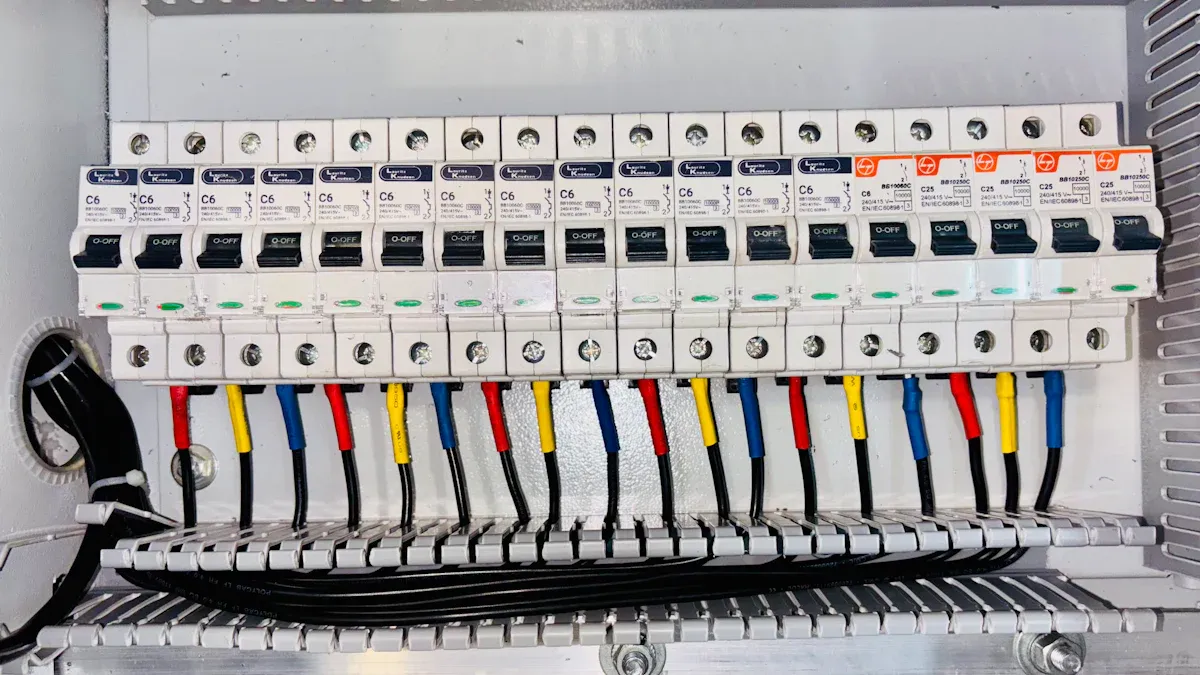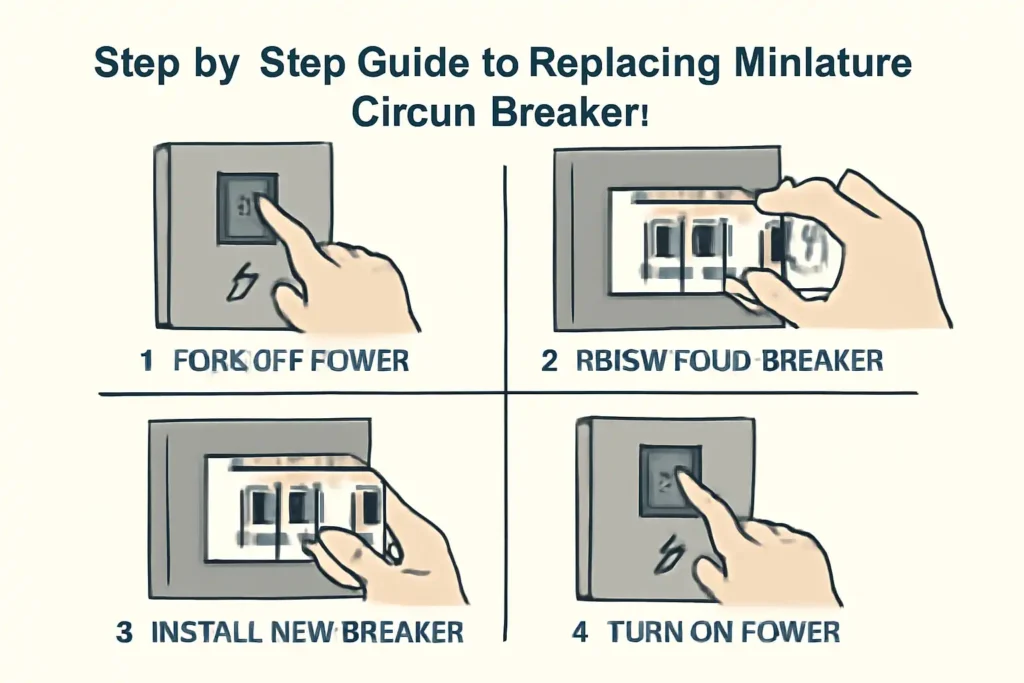You may wonder if you can replace miniature circuit breakers on your own. Always think about your safety first. Many areas have rules about electrical work, so check local codes before you start. Turn off the main power and use a voltage tester to make sure all circuits are de-energized. Choose a breaker that matches your panel and fits the correct amperage.
⚠️ Safety Tip: Never work on electrical panels unless you feel confident and follow all safety steps.
Key Takeaways
- Always prioritize safety by turning off the main power and testing wires before working on circuit breakers.
- Check local laws and consider hiring a licensed electrician to avoid legal issues and ensure proper work.
- Replace breakers if they trip often, feel hot, show damage, or fail to reset; do not ignore these warning signs.
- Use the correct breaker type and amperage that matches your panel to prevent fire risks and damage.
- Follow step-by-step instructions carefully, double-check your work, and test the circuit after replacement to keep your home safe.
Can You Replace It?
Safety and Legal Basics
Before you try to replace miniature circuit breakers, you need to know the safety and legal rules. Many places do not allow homeowners to do this work without a license. You may need a permit, and most utility companies will not help unless you hire a licensed electrician. If you do the work yourself, your home insurance might not cover any damage. Manufacturer warranties may also become void if you do not use a professional.
- A master electrician once shared a story about a homeowner who tried to replace a breaker. The homeowner made a mistake with the wiring, which caused a shock hazard and put everyone in danger.
- Professional electricians use special safety gear like insulated gloves, safety glasses, and arc-flash clothing. They also use tools such as calibrated torque screwdrivers and insulated pliers to make sure the job is safe and meets code.
- Electrical work must follow the National Electrical Code (NEC) and local rules. Inspectors check the work at different stages to keep everyone safe.
- If you work without a permit, you could face fines. You might also have problems selling your home later.
🛑 Tip: You can help by preparing the work area or labeling circuits, but let a licensed electrician handle the replacement.
When to Call a Pro
You should call a professional if you feel unsure or see signs of trouble. If you notice flickering lights, power outages, or a breaker that will not reset, you need expert help. Older homes with outdated wiring also need a professional inspection.
- You risk electric shock if you handle live wires or wire things wrong.
- Faulty wiring can cause electrical fires.
- DIY repairs may void your home insurance.
- You could face legal trouble for unlicensed work.
- Electricians have the training and tools to keep your home safe.
Remember, circuit breakers protect your home from fires and shocks. Always put safety first when you need to replace miniature circuit breakers.
When to Replace Miniature Circuit Breakers
Signs of a Faulty Breaker
You need to know when a miniature circuit breaker is no longer safe or working well. Faulty breakers can put your home at risk. Watch for these common signs:
- The breaker trips often, even when you do not use many devices.
- You smell something burning near the breaker panel.
- You see cracks, scorch marks, or other damage on the breaker.
- The breaker feels hot or warm when you touch it.
- You hear buzzing or crackling sounds from the breaker box.
- Lights flicker or appliances work poorly on the circuit.
- The breaker will not reset or stay on after you try.
⚠️ If you notice any of these signs, you should replace miniature circuit breakers right away to keep your home safe.
Replacement vs. Resetting
You may wonder if you should reset a breaker or replace it. Circuit breakers are made to trip and protect your home during overloads. You can reset them after a trip, which is easy and saves money. However, you should not ignore frequent tripping or other problems.
- Reset the breaker if it trips once and works fine after you fix the cause.
- Replace the breaker if it trips often, feels hot, or shows damage.
- Frequent tripping can mean a bigger electrical problem. In this case, call a professional.
- Breakers are not built for constant switching. Too much use can wear them out.
- Some special breakers can handle frequent switching, but most cannot.
🛠️ Always test and maintain your breakers. If you find any issues, do not wait to replace miniature circuit breakers. This step helps prevent electrical fires and keeps your home safe.
Preparation Steps

Tools and Materials
Before you start, gather all the tools and materials you need. This helps you work safely and finish the job without delays. Here is a list of what you should have ready:
- Replacement miniature circuit breaker that matches your panel’s brand, type, and amperage.
- Insulated screwdrivers and needle nose pliers for safe handling of wires and screws.
- Voltage tester or multimeter to check if wires are live.
- Rubber-soled shoes or a grounding mat to protect against electric shock.
- Insulated gloves and safety glasses to keep your hands and eyes safe.
- Flashlight or another light source, since you will turn off the main power.
- Wire strippers and crimping tools if you need to adjust or replace wires.
- Wire lugs and extra wires that match your breaker’s specifications.
🛠️ Tip: Always check that your new breaker matches the old one in type and amperage. Using the wrong breaker can cause damage or create a fire risk.
Power Off and Testing
You must turn off the main power before you replace miniature circuit breakers. This step keeps you safe from electric shock. Follow these steps:
- Switch off the main power at your service panel. Make sure all lights and outlets lose power.
- Set up a flashlight or battery-powered lamp so you can see inside the panel.
- Put on your insulated gloves and safety glasses.
- Inspect your tools and safety gear for any damage before use.
- Use a voltage tester to check every wire and terminal. Always test your voltage tester on a known live source first, then test the wires, and finally re-test on the live source. This “live-dead-live” method ensures your tester works.
- Never assume a wire is safe until you test it. Always treat wires as if they are live.
- Remove any jewelry or metal objects from your body before starting work.
⚡ Safety Alert: Only start work when you are sure the panel is de-energized. If you feel unsure at any point, stop and call a licensed electrician.
How to Replace Miniature Circuit Breakers

Replacing a miniature circuit breaker requires careful steps and attention to safety. You must always use a breaker that matches your panel’s brand and amperage. Never use a breaker with a higher rating than the wire allows. This can cause overheating and fire. Some panels only accept certain breaker types, so check compatibility before you buy a replacement. Always treat wires as live until you test them. For extra safety, shut off all branch breakers before turning off the main breaker.
Remove Panel Cover
- Put on your insulated gloves and safety glasses.
- Make sure the main power is off. Use a voltage tester to check that no electricity flows in the panel.
- Use a screwdriver to remove the screws holding the panel cover. Keep the screws in a safe place.
- Carefully lift the panel cover away. Watch out for sharp edges and do not touch any wires.
- Use a flashlight if the area is dark. Inspect the inside of the panel for any signs of damage or loose wires.
⚠️ Tip: Always keep your hands dry and stand on a rubber mat for extra protection.
Disconnect and Remove Old Breaker
- Find the breaker you want to replace. Label it with tape if needed.
- Make sure the breaker is switched off.
- Even with the main power off, some wires may still carry electricity. Test all wires with your voltage tester.
- Loosen the terminal screw on the breaker with your insulated screwdriver. Gently pull the wire out.
- Grip the breaker and pivot it outward from the panel. Some breakers pull straight out, while others need a slight angle.
- Set the old breaker aside.
🛑 Never force a breaker out. If it feels stuck, double-check for hidden screws or clips.
Install and Connect New Breaker
- Check that your new breaker matches the old one in brand, type, and amperage. Look at the panel label or manual for approved models.
- Align the new breaker with the correct slot in the panel. Attach it to the bus bar by pressing it firmly until it clicks into place.
- Strip the end of the wire if needed. Insert the wire into the terminal on the new breaker.
- Tighten the terminal screw securely. Loose connections can cause overheating or arcing.
- If your panel has a ground or neutral bar, connect the wires as shown in your panel’s diagram.
- Double-check all connections before moving on.
💡 Note: Keep your system diagram updated and label the new breaker for future reference.
Restore Power and Test
- Replace the panel cover and secure it with the screws you saved earlier.
- Make sure all tools and loose wires are out of the panel.
- Turn on the main breaker. Then, turn on each branch breaker one at a time.
- Use your voltage tester to check that the new breaker works. Plug in a device or turn on a light on the circuit to confirm power flows.
- Watch for any signs of trouble, such as buzzing or heat. If you notice anything unusual, turn off the power and call a professional.
✅ You have now learned how to replace miniature circuit breakers safely. Always follow these steps and never rush the process.
Final Checks and Troubleshooting
Test the Circuit
After you replace miniature circuit breakers, you need to test the circuit to make sure everything works safely. Start with a visual inspection. Look for any loose wires, missing screws, or signs of damage. Use a voltage tester to check that power flows correctly through the new breaker. Plug in a lamp or small appliance to confirm the circuit works.
You should also follow standard testing procedures. These include checking insulation resistance, contact resistance, and the mechanical operation of the breaker. The table below shows common tests and what they check:
| Test Type | What It Checks | How Often to Perform |
|---|---|---|
| Visual Inspection | Physical damage, loose parts | Every replacement |
| Insulation Resistance | Dielectric strength | Every 2 years |
| Contact Resistance | Connection quality | Every 2 years |
| Trip Testing | Breaker protection function | Every 2 years |
| Mechanical Operation | Wear and smooth movement | Every replacement |
These tests help you find up to 90% of problems before they cause trouble. Always record your results in a logbook or digital file. This helps you track performance and spot issues early.
📝 Tip: Use digital tools or apps to make testing faster and more accurate.
Common Mistakes
Many people make simple mistakes when they replace miniature circuit breakers. You can avoid these problems by following each step carefully.
- Picking a breaker based only on amperage, not checking the exact part number or brand.
- Removing the grease from the bottom of the new breaker, which helps with installation.
- Attaching wires under the screw head instead of between the contact plates, causing loose connections.
- Forgetting to label the breaker before removal, leading to confusion.
- Not turning off the main breaker or skipping the voltage test.
- Touching live wires at the top of the panel, which stay energized even when the main is off.
⚡ Always double-check your work and never rush. If you feel unsure, call a licensed electrician for help.
You play a key role in keeping your home safe when you replace miniature circuit breakers. Always choose the correct breaker and follow each step with care. Double-check your work and make sure you follow local codes. If you feel unsure or notice any problems, call a licensed electrician. Your safety comes first.
🛠️ Tip: Careful planning and attention to detail help prevent electrical hazards.
FAQ
How do you know which breaker to buy?
You need to match the brand, type, and amperage of your old breaker. Check your panel label or manual for approved models. Never use a breaker with a higher rating than your wiring allows.
Can you replace a breaker without turning off the main power?
No, you must always turn off the main power before starting. This step keeps you safe from electric shock. Always test wires with a voltage tester before touching anything.
What should you do if the new breaker trips right away?
First, turn off the breaker. Unplug all devices on the circuit. Try resetting the breaker. If it trips again, you may have a wiring problem or faulty breaker. Call a licensed electrician for help.
Is it safe to upsize a breaker for more power?
⚠️ Never upsize a breaker to get more power. The wire size limits the breaker rating. Using a larger breaker can cause overheating and fire.
How often should you check or replace breakers?
You should inspect breakers every two years. Replace any breaker that shows damage, trips often, or feels hot. Regular checks help prevent electrical hazards.
The following information may be of interest to you
How to replace the circuit breaker correctly
How to Test a GFCI Circuit Breaker Safely
Step-by-Step Guide to Replacing Your Circuit Breaker Panel



